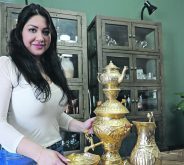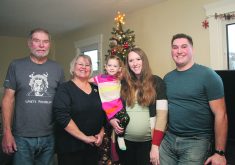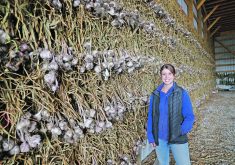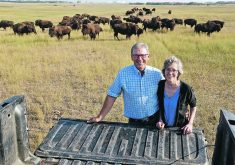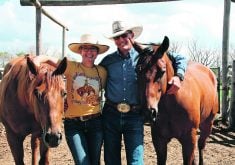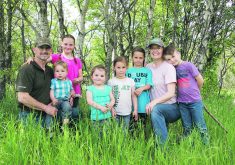Children put education to work | Mechanic, animal health technician and law student all keen on keeping farm in the family
CROSSFIELD, Alta. — Darcey and Leisa Gallelli are third generation farmers living through an agricultural revolution.
Their three adult children are as adept with computers as they are working cattle or farming the land. Even though the children have off-farm jobs, they have made it clear they are coming back.
That commitment to agriculture was the basis of a master farm family award from Rocky View County.
“You have to have that passion for it or it’s not going to work,” Leisa said from their home west of Crossfield.
Read Also

VIDEO: Bittersweet harvest for this family farmhand
Bruce Burnett helps his brother harvest wheat and canola for the last time on the family farm in Manitoba where they both grew up.
They live in the shadow of Calgary and the lure of better paying jobs elsewhere, but when things get hectic, their children, Russell, Raymond and Kelly, are at their side.
“Our plan was never to sell the land. It is to be passed on. It was passed on to us and it is going to be passed on to the next generation,” said Leisa.
“There are not a lot of farm families in our situation, where all three or four of the kids want to come back. It is an entirely different retirement plan,” she said.
The children appreciate the responsibility of keeping a multi-generation farm running. Many in Darcey’s and Leisa’s generation left for the city and never returned.
“A lot more kids are staying in this area from the time we started until now. That is when we lost all the farmers,” said Darcey.
The kids have a different idea.
“I would like to take over the operation and expand the grain side of things, but the way cattle keep going up, I would like to expand that, too,” said Russell, who is a journeyman agriculture mechanic.
Kelly is an animal health technician and works on a purebred operation near Red Deer. However, she has cattle and horses at the home place so she is never far away.
Raymond plans to return as well, once he completes his studies in economics at the University of Lethbridge and finishes law school.
Russell says many of his friends feel the same.
“We always head back to the farm where it’s all hands on deck,” he said.
The mixed operation came down through Leisa’s family, who came to Alberta in 1884.
Her grandfather, George Murdoch, came to Canada from Scotland in the 1850s and he followed the railroad west. He arrived in Calgary in 1883 and was the first mayor from 1884-86. His son was the first farmer in the family.
Darcey descended from Italian immigrants who first landed at Ellis Island in New York at the beginning of the 20th century and then headed west looking for work. Part of the family started a construction business in Calgary and another branch decided to farm.
These days they have more than 2,000 acres where they grow wheat, canola and malting barley. Their barley has won competitions in the past and is contracted to Rahr Malt, where it is used for craft beer.
Until recently, they also grew export timothy hay, but that business ended when the parents wanted to cut back on the workload.
They also cut back on the cow herd, selling their commercial herd in three packages and the purebred Charolais to P & H Ranching at Innisfail, Alta. Their children maintain a small herd, and both sons are active showmen.
They received their start with cattle through 4-H at the Crossfield Beef Club, where their parents were leaders. Russell and Raymond now work with youth conducting grooming and showmanship clinics.
“Every single one of them have gone back to their original clubs to help with events,” Leisa said.
The family also helped organize the youth program Summer Synergy at Olds, Alta., making sure Charolais were well represented.
Raymond had the grand champion commercial female this year and has earned about $5,000 in scholarships over the years.
Darcey and Leisa’s first home as a married couple 23 years ago was near Balzac, but they decided to move into a renovated house owned by Leisa’s parents as Calgary edged northward and they could see traffic lights from the tractor.
Part of their former farmland is now a northwestern Calgary community called Evanston.
Development pressures are top of mind, and they are disappointed to see high quality farmland covered by pavement.
Russell’s job takes him throughout southern Alberta, and he shakes his head over what is happening.
“They are developing some of the best land in Alberta. I see land from sandy clay to dry, dry land, where they can’t get a crop unless they run a pivot. We’ve got the best land right here,” said Russell.
However, his parents understand the reality.
“If farmers made more money from farming, they would not be so tempted to sell off that first parcel, but it is very tempting to do something like that when you can make so much money,” Leisa said.
The land is rich, but it is also part of an area called hail alley. They watch the skies all summer and cross their fingers that crops make it to harvest.
“The potential is there, but we don’t talk about it too much until it is in the bin,” said Leisa, who is an agronomist with an agriculture degree from the University of Montana.
She inspects the crops and watches the growth stages, determining whether they need pesticides or other treatments. She also has some private clients.
Darcey is a journeyman heavy duty mechanic and an early adopter of technology with plenty of support from his sons. While Russell and Darcey are both mechanics, their approach to work is different.
Whereas Darcey would have hauled his tools out to physically fix machinery, Russell uses an iPad to run computer diagnostics on tractors, balers, combines and sprayers.
“If I was to go out to a farm without my computer, I would be lost. It is not so much mechanical failures anymore. It is all electronics and hydraulics,” he said.
“Farmers are good and they can fix pretty well everything mechanical, but there are so many codes and systems on tractors and combines and drills, it is hard for the farmers to really remember everything that is going on,” he said.
The farm switched to a GPS system about 10 years ago and is now on a second generation of equipment.
“It was one of those things where you don’t jump in and learn it all at once. It takes years to learn that,” said Darcey.
They noticed a difference the first year.
“You are wasting less and you get a better crop overall because you don’t have overlaps. The overlaps were where you got all the problems in your crop, ” he said.
Russell appreciates his father’s expertise.
“All our fields are documented and boundaries outlayed, sloughs marked, rocks marked, well heads marked,” he said. “You go to a lot of different farms and you go to start a field, they don’t even have the boundaries marked. They are just using it for straight tracking, not for farming.
“You own this expensive technical piece of equipment and you are not using it to its full potential, whereas I think Dad is right up there using it to its utmost.”
The farm is such a good example of modernity and family values that it has become a favourite tourist destination.
Grain companies bring groups of Japanese and Americans every summer to examine the malt barley and the general operation.
The tourists can also see a family working together with long-term plans to continue rather than selling out to developers or a corporation. The family is the tie that binds.
“You won’t see a corporate farm that is four generations,” said Russell.






